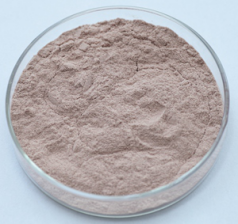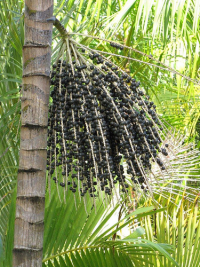Personlized Products Acai berry extract Manufacturer in Estonia
Personlized Products Acai berry extract Manufacturer in Estonia Detail:
[Latin Name] Euterpe Oleracea
[Plant Source] Acai Berry from Brazil
[Specifications] 4:1, 5:1, 10:1
[Appearance] Violet Fine Powder
[Plant Part Used]:Fruit
[Particle size] 80 Mesh
[Loss on drying] ≤5.0%
[Heavy Metal] ≤10PPM
[Pesticide residue] EC396-2005, USP 34, EP 8.0, FDA
[Storage] Store in cool & dry area, keep away from the direct light and heat.
[Shelf life] 24 Months
[Package] Packed in paper-drums and two plastic-bags inside.
[Gerneral feature]
- 100% extract from Acai berry fruit;
- Pesticide residue: EC396-2005, USP 34, EP 8.0, FDA;
- Directly import fresh frozen acai berry fruits from Brazil;
- The standard of the heavy mental is strictly according to the
foreign pharmacopoeia USP, EU.
- High standard of the quality of imported raw materials.
- Good water solubility, reasonable price.
[What is Acai berry]
The south American Acai palm(Euterpe oleracea)-known as the tree of life in Brazil-provides a small berry which is growing in fame, particularly following recent studies by well-known herbalists and naturopaths that have categorised it as a “superfood”. Acai berries are extremely rich in antioxidants, vitamins and minerals. The acai berry is also famous for its capacity to support dieting, protect the skin, reduce the risk of cardiovascular disease and prevent the development of certain types of cancer.
[Function]
While there are many different berry and fruit juices on the market, Acai contains the most complete array of vitamins, minerals, and essential fatty acids. Acai contains Vitamin B1 (Thiamin), Vitamin B2 (Riboflavin),
Vitamin B3 (Niacin), Vitamin C, Vitamin E (tocopherol), iron, potassium, phosphorus and calcium. It also contains the essential fatty acids Omega 6 and Omega 9, all the essential amino acids, and more protein than an average egg.
1)Greater Energy and Stamina
2)Improved Digestion
3)Better Quality Sleep
4)High Protein Value
5)High Level of Fiber
6)Rich Omega Content for Your Heart
7)Boosts Your Immune System
8)Essential Amino Acid Complex
9)Helps Normalize Cholesterol Levels
10)Acai Berries Have 33 Times the Antioxidant Power of Red Grapes and Red Wine
Product detail pictures:

Related Product Guide:
Attaining consumer satisfaction is our company's purpose without end. We will make wonderful endeavours to produce new and top-quality merchandise, satisfy your exclusive requirements and supply you with pre-sale, on-sale and after-sale services for Personlized Products Acai berry extract Manufacturer in Estonia , The product will supply to all over the world, such as: Australia, Amsterdam, Belgium, If any product meed your demand, please feel free to contact us. We're sure your any inquiry or requirement will get prompt attention, high-quality products, preferential prices and cheap freight. Sincerely welcome friends all over the world to call or come to visit, to discuss cooperation for a better future!
Video abstract of Original Research paper “Ulva lactuca polysaccharides prevent Wistar rat breast carcinogenesis through the augmentation of apoptosis, enhancement of antioxidant defense system, and suppression of inflammation” published in the open access journal Breast Cancer – Targets and Therapy by Abd-Ellatef et al.
Background: Recently, several research studies have been focused on the isolation and function of the polysaccharides derived from different algal species, which revealed multiple biological activities such as antioxidant and antitumor activities. This study assesses the possible breast cancer chemopreventive properties of common seaweeds, sea lettuce, Ulva lactuca (ulvan) polysaccharides using in vitro bioassays on human breast cancer cell line (MCF-7) and an in vivo animal model of breast carcinogenesis.
Methods: Cytotoxic effect of ulvan polysaccharides on MCF-7 was tested in vitro. For an in vivo investigation, a single dose of 25 mg/kg body weight 7,12-dimethylbenz[a]anthracene (DMBA) and ulvan polysaccharides (50 mg/kg body weight every other day) for 10 weeks were administered orally to the Wistar rats.
Results: Deleterious histopathological alterations in breast tissues including papillary cyst adenoma and hyperplasia of ductal epithelial lining with intraluminal necrotic materials and calcifications were observed in the DMBA-administered group. These lesions were prevented in the DMBA-administered group treated with ulvan polysaccharides. The immunohistochemical sections depicted that the treatment of DMBA-administered rats with ulvan polysaccharides markedly increased the lowered pro-apoptotic protein, p53, and decreased the elevated anti-apoptotic
marker, bcl2, expression in the breast tissue. The elevated lipid peroxidation and the suppressed antioxidant enzyme activities in DMBA-administered control were significantly prevented by
the treatment with ulvan polysaccharides. The elevated levels of inflammatory cytokines tumor necrosis factor-α and nitric oxide were significantly ameliorated in DMBA-administered rats treated with ulvan polysaccharides as compared to DMBA-administered control.
Conclusion: In conclusion, ulvan polysaccharides at the level of initiation and promotion might have potential chemopreventive effects against breast carcinogenesis. These preventive effects
may be mediated through the augmentation of apoptosis, suppression of oxidative stress and inflammation, and enhancement of antioxidant defense system.
Read the Original Research paper here https://doi.org/10.2147/BCTT.S125165
https://www.topallreviews.com/naturalmale
Porn Star Secrets Revelead
You will learn the 1 Secret Pornstar Use to Mighty Hard Dicks. This means girls will BEG YOU FOR SEX, See Video Now!
In China, we have purchased many times, this time is the most successful and most satisfactory, a sincere and realiable Chinese manufacturer!








